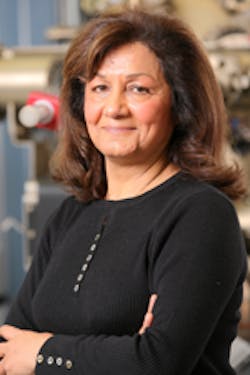Razeghi and group develop small, narrowband room-temperature terahertz source

Evanston, IL--A chip containing two mid-IR quantum-cascade (QC) lasers is at the heart of a small room-temperature terahertz-radiation source developed by researchers at Northwestern University.1 Using intracavity difference-frequency generation, the chip emits 4 THz radiation with a linewidth of only 6.6 GHz and an output power of up to 8.5 μ.
The research was headed by a scientist well-known for her work on QC lasers—Manijeh Razeghi, a professor at Northwestern University's McCormick School of Engineering and Applied Science.
As is well-known to Laser Focus World readers, terahertz radiation can be used for security screening, terahertz-absorption spectroscopy for detecting biological and chemical compounds, and, through mixing, detection of weak terahertz signals from deep space.
Coherent terahertz radiation has historically been very difficult to generate, and the search for an easy-to-use, compact source continues today. Existing terahertz sources are large, multi-component systems that may require complex vacuum electronics, external pump lasers, and/or cryogenic cooling. A single-component device without any of these limitations is highly desirable for next-generation terahertz systems.
Razeghi and her group at the Center for Quantum Devices have addressed two key issues that have limited the usefulness of initial demonstrations of mid-IR difference-frequency generation of terahertz radiation. Razeghi’s group currently leads the world in high-power QC-laser technology; by increasing the power and beam quality of the mid-IR pumps, the terahertz power has been significantly increased by more than a factor of 30.
The researchers also incorporated a novel dual-wavelength diffraction grating within the laser cavity to create single-longitudinal-mode mid-IR sources, which in turn led to very narrow-linewidth terahertz emission. The terahertz spectrum is extremely stable with respect to current and temperature, which could make the device valuable as a local oscillator for low-light-level receivers like those needed for astronomical applications.
“Our goal is to reach milliwatt power levels and incorporate tuning within the device,” says Razeghi. “Theory says that it is possible, and we have all of the tools necessary to realize this potential.”
Razeghi’s work in this area is partially supported by the Defense Advanced Research Projects Agency (DARPA). She would like to acknowledge the interest and support of Scott Rodgers of DARPA and Tariq Manzur of the Naval Undersea Warfare Center.
REFERENCE:
1. Q. Y. Lu et al., Applied Physics Letters 99, 131106 (2011); doi:10.1063/1.3645016.

John Wallace | Senior Technical Editor (1998-2022)
John Wallace was with Laser Focus World for nearly 25 years, retiring in late June 2022. He obtained a bachelor's degree in mechanical engineering and physics at Rutgers University and a master's in optical engineering at the University of Rochester. Before becoming an editor, John worked as an engineer at RCA, Exxon, Eastman Kodak, and GCA Corporation.